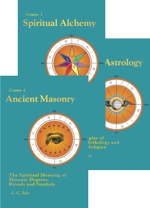| |
|
|
| |
 |
|
| |
 |
|
| |
 |
|
| |
 |
|
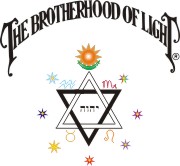
Serial Lesson 167
From Course XVII, Cosmic Alchemy, Chapter 4
Original Copyright 1946, Elbert Benjamine (a.k.a. C. C. Zain)
Copyright 2012, The Church of Light
Subheadings: Selective Breeding Biological Basis of Heredity Like Produces Like The Mental Method The Astrological Method The Radiational Method Sex-Linked Characteristics The Environmental Method
Illustrations: Diagram 1 Diagram 2 Diagram 3 Diagram 4 Diagram 5
Chapter 4
Heredity and Environment
MANY theories for the betterment of the human race seem so plausible that they strongly seize the imagination of the partially informed and are rushed into legislation on the tide of well-meaning enthusiasm. Already certain eugenic measures have been seriously considered by some of the lawmakers, and the future may well bring to pass a demand for legislation aimed at bettering the human stock through permitting only a favored class to bear children.
Not only is this method highly impractical, except for weeding out a very small group of defectives, as will later be explained, but it may be used by the politically unscrupulous as a club held over those who fear being deprived of parenthood. And what is even more significant, it may also be used to blind the people to the importance of superior living conditions as a far more effective means by which may be developed a higher type of man.
It is true that Nature has made use of selective breeding to perfect her various forms, and that stockmen use it successfully in developing superior strains, as do florists and nurserymen. Why, then, the layman has a right to inquire, cannot the same methods be used to produce finer strains of humanity?

Selective Breeding
Undoubtedly they could if as ruthless methods were applied to human breeding as to the production of other stock. The first principle of successful selective breeding requires innumerable individuals from which to select only the few individuals which show qualities in the desired direction. All the rest must be prevented from propagating. Out of twenty thousand young plum trees, for instance, Burbank would select not over a dozen, and the balance would be consigned to the flames. From these picked individuals, as large a number of offspring would be produced as possible, and from these only a few showing desired tendencies would be selected. The others would be destroyed.
By inbreeding, outbreeding, and constant selection, it is possible to build up in animal stock such qualities as are desired. But only by prohibiting the reproduction of any but a very few picked from as large a number of individuals as possible. These selected few also must then be united to produce progeny, not just as they choose, but between such individuals as the breeder indicates, and he must be able to bring about union between any individuals that fit into his plan.
To start with, he must have a clear idea of the qualities for which he works. Then he must apply his methods with complete thoroughness over a long period of time. Selecting a few individuals showing a tendency in the desired direction, he will mate only these. Then he inbreeds the result, mating brothers with sisters, and parents with offspring, to bring both the strong points and the defects into prominence.
As a result of this inbreeding, a great number of deformed and defective individuals will result, along with a few that show no defects. This host of defective individuals is eliminated, and the more perfect specimens are bred again with close relatives. Again the vast majority are dwarfs, cripples, or in some manner decidedly inferior; a few only showing superior traits. In fact, his object in inbreeding—which is the breeding of close relatives—is to bring the defective traits together, that they may be eliminated from the stock by removing the individuals in which they appear.
Humanity, however, discourages mating close relatives for the very reason that in this manner the defective qualities are brought to the surface and many of the resulting progeny tend to be deaf, blind, crippled, insane, or otherwise defective; even though in a limited few of the individuals so produced certain strong traits are usually accentuated.
But the practical stock breeder unites close relatives deliberately to bring defectives into the world that they, along with the weaknesses they carry, may be eliminated from the strain. Continuing this process to get rid of defects, at intervals he also crosses the few superior individuals left from the discarding process to strengthen the qualities desired, and then for a few generations again inbreeds the progeny to still further get rid of the undesirable qualities by producing and restraining from reproduction other defective individuals. Given such complete control over his stock, with time enough a marked improvement can be brought about.
But I cannot think, at least in our time, that humanity will consent to the deliberate production of defective children, through inbreeding, for the purpose of eliminating them, and the defects they carry, from the human race. Nor that it will consent to prevent all propagation except that of a few individuals selected by a practical breeder, nor that it will permit this breeder to determine whom among these few thus selected may unite. As a preliminary hindrance, I think it would be unusually difficult, with the diverse ideas afloat as to the purpose of life, to get people to agree even on just what qualities for which it would be best to work. Yet with these qualities selected, and a practical breeder in charge, with power to compel breeding as he chose, and to prevent all other breeding, it seems quite certain that a new and superior human type could be built.

Biological Basis of Heredity
Just why inbreeding tends to bring the defects to the surface requires an understanding of the biological basis of heredity. The microscope and the laboratory, during the last two decades, have yielded a vast amount of definite information on this subject, so that what previously was surmise is now definite knowledge. It is knowledge of the kind that enables the experimenter repeatedly to get a specific result from a specific combination. A very wide literature has developed, dealing with these experiments and microscopical studies; but the limitations of this chapter (Serial Lesson167) enable me to touch only the more salient points. And even so, as World War II has now ended, and scientific men can return to the research closest to their hearts, any detailed experiments I might cite will no doubt soon be outdated by others made possible by more highly specialized apparatus.
In Chapter 5 (Serial Lesson 3), Course II, Astrological Signatures, I have already made some mention of the chromosomes as the physical carriers of heredity, of how these filaments within the reproductive seed reduce to half their original number before fertile union with a cell of opposite polarity, and how the new cell, which by cell division produces the offspring, thus obtains half of its chromosomes from the mother and half of them from the father.
It is now further known that these chromosomes, which in each species are of a definite number, are composed of many hundred beadlike bodies strung together in a very definite order. That is, the nucleus of the reproductive cells carry filament-like chromosomes, which in turn are made up of beadlike strings of smaller bodies called chromomeres. These chromomeres not only are the physical carriers of heredity, but in a given species of animal each bead in the string always governs some particular characteristic, and always occupies the same position in the string. Thus bead No. 3 may govern the color of the eyes, No. 4 the shape of the nose, and No. 5 the texture of the skin; and it may be depended upon that the given characteristic is governed by the bead of this number, and not by some other bead.
The definite hereditary characteristics which are carried by the chromomeres are called genes. But the foremost biologists do not assert that the physical beads, or chromomeres, are the actual elements of heredity. They say that the actual elements of heredity, whatever they may be, always seem to be associated with these physical beads according to a definite plan. From the standpoint of occult science, the actual elements of heredity are the vibratory rates in the astral substance associated with the beads. But because the elements of heredity are so associated, it is convenient to use these physical beads, that may be seen with a strong microscope to be strung along the filaments of the chromosomes, as the actual genes.
One string of genes is supplied by the mother, and one string by the father, so that for every hereditary characteristic there are two beads, one of the pair furnished by each of the parents. And No. 3 in each string has to do with the same characteristic, so that both members of the pair always have an influence, let us say, over the color of the eyes. Each member of any pair of genes, one of the pair being furnished by each parent, thus always has the same general function.
This doubling of the genes is nature?s insurance against defectiveness; for commonly if one member of the pair is defective, the other sound gene has strength enough so that no defect appears in the offspring. That is, if the gene from the mother governing hearing is defective, the mother being deaf, and the same gene from the father is sound, the offspring would show no weakness in this respect. But if both members of the pair were defective, the offspring would be deaf.
The normal gene, because of its strength to impress its qualities on the offspring, is called dominant; and the defective gene, because it has much less power to influence the offspring, is called recessive. As a matter of experiment it is found, according to the long recognized Mendel?s Law, in random matings when the dominant genes and the recessive genes for the same characteristic are equally numerous that the offspring show the characteristics of the dominant genes three times as often as they show the characteristics of the recessive genes. This results because when a dominant gene pairs with a recessive gene the dominant characteristic shows, as it does also when a dominant pairs with another dominant. Only when two recessive genes governing the characteristic are paired does the defective trait commonly appear in the offspring.
Dominant genes that are a disadvantage do occur, but are extremely rare. One, for instance, is that which causes the fingers to have only two joints instead of the normal three. But usually the dominant gene of a pair determines a characteristic that is beneficial to the individual. In a state of natural competition between forms of life there is thus a gradual weeding out of the recessive genes through the failure to live and propagate of those individuals that are weakened by the possession of two defective genes of the same pair.

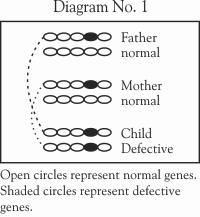
CHILDREN INFERIOR TO BOTH PARENTS (See diagram No. 1, left): This also explains why children sometimes possess characteristics that are exhibited by neither of the parents. In both parents, and perhaps in the more remote ancestors as far back as can be traced, because in each instance a recessive gene was paired with a dominant gene, the characteristics were strong and normal. In their children, likewise, it would be possible that the dominant gene of one would unite with the dominant gene of the other to produce normal results. Also, if the dominant gene of one united to the recessive gene of the other, the result would be a normal child. Or if the recessive gene of the one united to the dominant gene of the other the result would be normal. Any one of these three combinations would produce a child normal like the parents.
Averages, where human reproduction is concerned, according to the teachings of occult science, are upset by the mental attitude of the parents previous to, and at the time of, conception. But if we disregard mental and emotional factors as having an influence, on the average of one child out of every four, from parents such as we are considering, would be defective, and thus unlike either parents, because it would get the one recessive gene from the father and the one recessive gene from the mother in the same pair. Thus from two sound parents can be born, through the known laws of inheritance, a child that is feebleminded, deaf, blind, lame, lazy, irritable, or incorrigible.

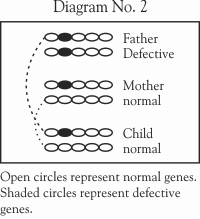
CHILDREN LIKE SUPERIOR PARENT (See diagram No. 2, left): If one parent has a pair of genes composed of one dominant and one recessive, and the other parent has the same pair composed of two recessives, the one parent will be normal and the other parent will be defective. Under such circumstances a child may receive a gene that is recessive from one parent, and a gene that is dominant from the other parent, and thus be quite normal, like the superior parent.

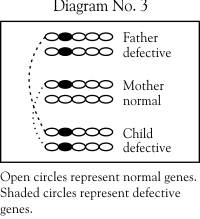
CHILDREN LIKE INFERIOR PARENT (See diagram No. 3, right): Or from the same parents a child may get a defective gene from the father and a defective gene from the mother, both in the same pair, and thus exhibit the weakness of the inferior parent.

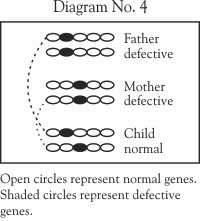
CHILDREN SUPERIOR TO BOTH PARENTS (See diagram No. 4, left) Feeblemindedness, indolence, incorrigibility, irritability and other deficiencies often arise in different people from genes that are not of the same pair. That is, two people may both be feebleminded, but not exactly feebleminded in the same way. Two people may be deaf or blind, and the deafness, or blindness be a slightly different kind of deafness or blindness, arising not from the same, but from adjoining pairs of genes. Of course, in people who are closely related, a defect affecting a given part usually arises from the same pair of genes, but with people not closely related it may well arise from genes lying in quite different pairs.
The defect for feeblemindedness may come from one pair of genes that are recessive in one individual, and from another pair of genes that are recessive in another individual. These two, when they unite, may then contribute one dominant gene to each defective pair of the other, so that both pairs of genes in the offspring have one normal gene. Thus from two feebleminded parents it is quite possible to get children who are bright and intelligent, superior to both parents.

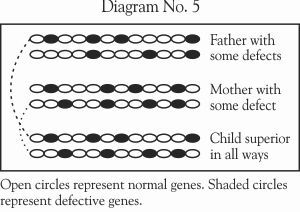
GENIUS (See diagram No. 5, left): Defective genes are scattered very thoroughly throughout the human race. When the happy combination of genes occurs in which the defective genes of one parent are paired with normal genes of the other parent, they become supplementary, and bring forth a strong trait. And sometimes the defective pairs of one string may be united only to normals in the other string, and the recessives in the other string only to normals in the one string. Thus the strong points are all brought out, and the weak points from both parents are entirely submerged. To the extent this takes place, we have an individual who in all respects is superior.
We have discussed these strings of genes as if they were each an unbroken string, when as a matter of fact there are a number of sections of filament, each section called a chromosome. From the father, then, a child may get a certain segment from either the father?s father, or the father?s mother. Certain genes that do not give much evidence may come from still more remote ancestors, and be carried along unnoticed until brought into combination with another segment that permits them more pronounced expression. That is, in outbreeding, such as is the custom of humanity, the hereditary genes of the 48 distinct chromosomes that are contained in each human reproductive cell have opportunity to make an infinite number of different combinations, producing very diverse individuals. And when certain unusual combinations occur that afford supplementary genes that cover up common defects, and that bring a number of striking dominant genes together as qualities in a single individual, we have the physical requirements for genius.

Like Produces Like
Tall parents have more tall offspring on the average, because the genes giving tallness are more numerous than those giving shortness. Yet on the average some short offspring will occur, because the parents nearly always have some genes giving shortness. So with eye color, with facial resemblance, and with traits of character. People of the same family more often resemble each other, because they have more genes in common than people not of the same family. Yet, on the average, because of the diverse manner in which genes combine, the difference between members of a family are about one-half as great as the differences between those not closely related. That is because, and not in violation of, the known processes of inheritance, certain members of a family are unlike other members of the same family.
Furthermore, because the method employed in the human race to improve it has been to cover up the defective genes through marriage with another who has the same genes normal, we find about the same genes, or inheritance factors, scattered throughout the human race. People, mostly, who are inferior, delinquent, criminal, stupid and otherwise defective because of inherited traits, merely happen to have two defective genes in the same pairs, while the normal individual has more normals paired with the same defective genes, and the decidedly superior person has a happy combination in which the defective genes in both strings are largely supplemented by a dominant of the same pair.
This covering up process has gone on from primitive times. The laws of the tribe usually do not permit individuals of the same clan to marry. A man of one totem must marry a woman of a different totem. The utmost pains are taken by savage people, and laws are passed in civilized countries to prevent close relatives from marrying. The marrying of close relatives, because the genes are so similar, tends to bring the defective genes into pairs, and the dominant genes together in other pairs. This pairing of recessive genes results in defective individuals. But when by marriage with one to whom there is no close relationship, a dominant is paired with a defective, the defective gene is not removed from the race, for it will still persist and will be passed on to the next generation. Yet it is covered up, and the individual who carries it, and who passes it on, is normal.
Because the various genes, both normal and defective, have been so thoroughly scattered throughout humanity, the eradication of deficiency due to recessive genes is too slow to make the claims of eugenics very attractive. Although the time may come when by chemical analysis, or by other means, it can be determined what genes an individual carries that are dominant and what genes he carries that are defective, there is no way at present to determine this except in the small class of individuals who have both members of a pair recessive, and are therefore deficient. Yet these represent but a small number of those who possess at least one of the defective genes, and who therefore are carriers of it, so that in the next generation it may pair with another recessive, and defectiveness result.
According to the latest statistics available, the feebleminded make up about 1/3 of 1% of the population, say 440,000 in the U. S. A. Supposing these all to be due to heredity, they each have a single pair of defective genes, and by calculation the known proportion of those who have a single gene to those who have both members of a pair alike, it works out as 10% of the population, or say, there are 13,200,000 normal individuals who carry feebleminded genes. There is left, then, some 118,360,000 people in the U. S. who carry no feebleminded genes.
If it were possible to prevent the 440,000 feebleminded and the 13,200,000 carriers from producing offspring, hereditary feeblemindedness would disappear in a single generation. But at present there is no way to distinguish the 13,200,000 carriers from the 118,800,000 who are not carriers of this defective gene.
According to R. A. Fisher, 11% of the feebleminded of any generation come from the mating of those who are feebleminded, and 89% come from the mating of the normal individuals of the carrier group. We thus could get rid in one generation of 11% of hereditary feeblemindedness by prohibiting all feebleminded persons from bearing children; but the carrier group would still produce 391,600 feebleminded, and after the 11% were removed further reduction would be increasingly slower. So slow that Fisher computes that if the proportion of the feebleminded were one in a thousand normal individuals, that it would require 68 generations, or two to three thousand years, to reduce the number to one in ten thousand normal individuals by prohibiting the feebleminded from propagating.
There can be no doubt that certain individuals should not be permitted to propagate, and I have no intention of disparaging the value to society of getting rid of 11% of defectives of certain types in the first generation by making it impossible for them to bring children into the world. But at the same time I do not feel that a process that requires thousands of years to reduce the number to one-tenth their present strength, and that would not completely eradicate them even after several thousand years more, holds forth any great promise of effectively eliminating from our midst the delinquent, the feebleminded, the insane, the criminal, and the otherwise seriously defective.
There are, however, four other methods—the mental, the astrological, the radiational, and the environmental—each one of which offers the hope of much swifter and satisfactory solution to the problem. The mental yet requires competent experimental research to determine just what results may be expected from it. The radiational method also requires experimental work to develop a proper technique. But enough is known about the astrological method and the environmental method to make it quite certain that swift and positive results of a most favorable nature may be obtained from their application.

The Mental Method
In the ancient mysteries it was taught, as I have explained in detail in Course IV, Ancient Masonry, that the power of thoughts and aspirations of the parents preceding their union have a definite influence upon the general type of soul attracted to them for incarnation. And it was emphasized that in addition to the general level of harmony or discord maintained customarily by them, that the specific thoughts and emotions, as well as their intensity, at the time of union attract to them, by the magnetic field thus set up, a soul that corresponds closely in its aspirations and in its harmonies and discords, to their combined thought energies then set in motion.
Although their teachings also embraced the effect of loving emotions and kindly thought images to rejuvenate and revitalize each other, the most important part of the ancient Ansairetic Mysteries revolved around how, through formulating and holding an ideal mental pattern, superior children might be brought into the world. The teaching was known to initiates as the Legacy of Aphrodite.
Now it is anything but scientific to draw conclusions from a few known instances. But every now and then through the newspapers, or through personal acquaintance with the case, instances are brought to the attention in which one parent, being deeply in love with someone from whom separated, holds the image of this loved one in the mind strongly and constantly, and that a child is born greatly resembling this absent person, who is not the other parent.
As a single instance of this power of mind to shape the image of the unborn child, there was given in the Los Angeles Daily News, issue of Feb. 13, 1931, the picture of Nancy Ellen Crouch, nine years of age, together with the picture of the bust of a child by Tochini, showing the remarkable resemblance between the two. This bust was then 130 years old. The father is quoted as saying that previous to the birth of the daughter he had loved this bit of statuary ardently, had it in his mind almost constantly, and even called it his little marble daughter. Is it any wonder that the child was an almost exact image of the face portrayed in marble?
Just how potent such mental influences are will never be known until experiments are made and data carefully collected to determine it. But we do know that from the same parents are born children possessing the most diverse qualities. With a million sperms present, containing, we may suppose, strings of genes derived in various proportions from different ancestors, there is opportunity for unusually favorable, or unusually unfavorable, combinations. Unlike Hereford cattle, or Reid?s yellow dent corn, humans do not breed true to type, because strains have not been made permanent through inbreeding and selection. Something, nevertheless, determines that one particular sperm out of the million present shall reach and fertilize the ovum. Something determines that the gene string furnished by the female, likewise, is one string and not another.
I know of no experiments to determine if the thoughts and aspirations of the mother previously have an influence on which string of genes is expelled and which retained during the process of maturation. Nor to determine if the combined thoughts of both parents at the time of union give a magnetic polarity to a certain sperm that enables this particular one of the million present to reach and fertilize the ovum. These things have not been experimentally determined yet, but they offer a most attractive and useful field of investigation.
We do know, however, that something, and not mere chance, determines the string of genes possessed by the fertilized egg, and that, consequently, will be possessed by the child. And we do know that in both plants and animals when the gene combinations are supplementary that there may be striking results. Certain races of maize, for instance, both of which are short, weak, spindling, and producing almost no yield of corn, when mated together give large, vigorous offspring with a high yield of corn. Also, our great geniuses often have brothers and sisters who show no remarkable traits. Either the thoughts and emotions of the parents were different when genius was conceived, or some other condition was present, that determined the unusual combination of genes that made genius possible.

The Astrological Method
Of these other conditions the planetary influences at the time are certainly most potent factors. By gauging the time of conception one may determine, within certain limits, the kind of birth chart a child shall have. Looking 273 days ahead in the ephemeris will indicate the sign the sun will be in at birth, and also the distribution and aspects between the heavier planets. It is true that conception may not be coincident with union. But in several instances known to me personally in which the time was selected for union with a view to having a child with a particular birth chart, following the general rule regarding the prenatal epoch and birth, in each the degree of the moon at the time of union became either the degree on the Ascendant or Descendant, as indicated by the rule, at the time the child was born.
I must confess, however, that on several other occasions I have assisted friends to pick a time for union that would give the child an unusually favorable birth chart in which the results were not so favorable because there was no conception. It is doubtless too much to expect that merely by picking a favorable time for union that just any combination of parents can give birth to a marvel of intelligence and nobility. In the instances cited, it may have been that the emotional and mental levels of the parents were not high enough to attract a soul of the marked qualities they hoped their child to possess, or it may have been due to other conditions.
Usually the planetary configurations to give an unusually favorable chart are present only at rather long intervals, and parents who desire children often do not care for the postponement necessary to bring a child into the world during one of these exceptional periods. But even within the period of a year some times are far more favorable than others. If, for instance, two heavy planets are in opposition, it is possible to have a child born when the sun is square to both, or when the sun is trine to one and sextile the other. Furthermore, the rather limited experience I have had with the selection in advance of the birth chart of a wanted child convinces me that the selection of the rising sign by observing the position of the moon at the time of union is not only well worthwhile, but quite feasible. Anyone who is familiar with rectification of the horoscope by means of the prenatal epoch, as explained in Chapter 8 (Serial Lesson 117), Course X-II, Progressing the Horoscope, will be able to determine, by means of the same rule, when a child should be conceived to have a certain birth chart.
Undoubtedly, we still have a great deal to learn about predetermining the birth chart, and thus the character of the child, through the application of astrological laws; but my own observation of actual results thus obtained convinces me that even with our present knowledge we can improve the race through this means quite rapidly and effectively. It is well worth a trial, instead of the ordinary hit and miss method, by anyone contemplating the bearing of offspring.

The Radiational Method
Aside from the unusual individuals produced by unique gene combinations, we have in nature other marked alterations produced by changes in the materials of which the genes are composed. As observed by intensive study, the unknown agent in nature that commonly causes the change is so minute that it affects only one of a pair. When, however, the substance of which the gene is composed is changed, the characteristic it influences in the offspring is likewise changed. Furthermore, the divergence from type is an inheritable quality. That is, any changes in the structure or functions of the offspring that are brought about by alterations in the substance of the genes—and such changes often are remarkably great—become a permanent acquisition of the strain. Such changes are observed in nature, often giving entirely new types. And these new types breed true. From such mutations, as they are called, new strains also are derived under artificial conditions.
Most mutations, as observed experimentally, are disadvantageous to the organism. But as occurring in nature, some are no doubt advantageous and give a superiority that enables the organism to survive in competition with others in which the new characteristic is lacking. Hundreds of new varieties of animal life have been produced in the laboratory by artificially stimulating mutation. These new varieties breed true to the new type; and it is quite certain that in nature new species are derived through a similar process.
One of the most interesting things about these mutations is that they can be, and are, produced by radiations. It is interesting, among other reasons, because we are just moving into a period of history in which atomic fission apparently will be used widely as a source of industrial energy, as well as in bombs during warfare. And atomic fission is accompanied by radiations of great power. The question is thus raised not merely how extensively these radiations may cause mutations in the plants and animals accessible to them, but also what mutations they may cause in the human species.
It is known, through extensive experiments, that when a developing organism is exposed to the X-ray, which is less powerful than some of the radiation of atomic fission, that some of the genes are altered without being destroyed. Not all the genes are so altered, but enough of them that the resulting organism is an entirely new type. Other radiations in nature also affect the gene structure. Babcock and Collins, as well as Hanson and Heys, carrying out extensive investigations, are of the opinion that the mutations that are known to take place in nature, and that occur spontaneously in the laboratory, result from some natural source of radiation. They bred fruit flies in a region where there was little radiation, and others in a region where the radiation was known to be about twice as great. It was found that the number of mutations was much greater in the region where natural radiation was most intense.
As yet we have not advanced far enough in our knowledge of the effect of such radiation upon the substance of the genes to be able to apply it intelligently with a view to changing the genes in a manner that will give desirable and predetermined results. But with the knowledge that the genes, and thus the inheritance factors, can be thus influenced, we may hope confidently that the method, more and more, will be brought under control, and ultimately, through preliminary experiments on lower forms, be brought to a state of perfection in which it may be applied effectively to the betterment of the human stock.
In the experiments referred to, the radiations were those of radioactive minerals within the earth?s crust. But these, X-rays, and the emanations accompanying atomic fission are by no means the only radiations that possibly may produce a profound effect upon the structure of the genes. Both the thoughts of the parents and the radiations of the planets may very well, not merely determine the gene combination which takes place at conception, but also may have an influence to alter the gene material at the time of union and during the process of gestation. Material science, I know, scoffs at birthmarks and all such influences of the mind of the mother over her babe during gestation. But the number of those who read this who personally know of instances where happenings to the mother have impressed themselves on the babe is so great that I feel it unnecessary to offer comment or detailed proof.

Sex-Linked Characteristics
Just at this point, and before a discussion of the environmental method of improving the human stock, some mention should be made of sex-linked characteristics. These characteristics explain why the daughter always inherits certain characteristics from her father, and why the son always inherits certain characteristics from his mother.
It has been found in certain animals, notably insects, that the female at the very beginning of its existence as a single cell always has one more chromosome than the male. The female has an even number of chromosomes, the two of each pair being alike; but instead of one of these pairs the male has a single chromosome, called X chromosome. But in other animals, including man, the X chromosome of the male has for its mate a minute and rudimentary chromosome, called the Y chromosome. The Y chromosome does not appear in females. This makes it possible to trace a particular X chromosome, or a particular Y chromosome, from one generation to another, along with the group of characteristics determined by its genes.
The germ cells of a woman contain 48 chromosomes, including two X chromosomes. The germ cells of a man contain 48 chromosomes, including one X chromosome and one Y chromosome. The X chromosome of a father, together with the different characteristics it influences, always passes from a father to his daughter, never to his sons. The sons always get their single X chromosome and the different characteristics it influences, from the mother, and never from the father. Thus it is possible to trace from generation to generation, from father to daughter, and from mother to son, those particular qualities that are gathered together in the chromosome that also determines sex.
This discovery of the sex chromosome also substantiates a very ancient occult doctrine; the doctrine that a male is a male, and a female is a female, from the very moment of conception. This doctrine was brought into some question through the discovery of the effect of the endocrine glands in altering secondary sex characteristics. But if the present teachings of biology are correct sex is far more deep-seated than any external qualities or actions. Gland treatment may cause a female to develop strong male tendencies and a masculine appearance, but the real sex is part and parcel of the cells. At conception, if there are two X chromosomes the child is a girl and its germ cells will always have two X chromosomes. If at conception there is an X chromosome and a Y chromosome, the child is a boy, and its germ cells all continue to carry the Y chromosomes. A female soul may have a body that expresses masculine characteristics, but the germ cells, each containing two X chromosomes, definitely determines the sex as female. Nor can we imagine a male soul incarnated in a female form. Such impressions are due merely to external appearances.

The Environmental Method
Thus far we have considered the genes as if they of themselves produced the characteristics observed in heredity. But experiments very completely show that the genes produce certain effects under one set of conditions, and that under another set of conditions the same genes give rise to very different attributes.
Thus an individual that normally would become a female, having two X chromosomes, develops many male characteristics if the male hormone is caused to circulate in its body, or if its ovary is removed and a male gland is substituted. A child that otherwise would become a cretin, a dwarfed imbecile, becomes an intelligent, normal person when fed thyroxin. And this thyroid chemical can be manufactured synthetically, as can the active principle of some of the other endocrine glands. Thus, to a great extent, the genes are dependent upon the endocrine glands in developing their hereditary traits, and the glands in turn, to manufacture a normal quantity of their secretion, are dependent upon certain vitamins and other factors in the diet. Thus can certain hereditary traits be altered and certain hereditary deficiencies overcome by supplying the factors that enter into the composition of the gland secretions.
Not only do the vitamins profoundly affect the development of an organism, but many instances can be cited in which the external environment affects a hereditary character. Thus R. A. Emerson found that the hereditary color of maize may be altered by growing conditions. Red plants produce red offspring, and green plants produce green offspring. Yet true red plants grown in the shade are green like the green plants which are green through heredity.
To what extent characteristics which are acquired through the influence of environment are inherited by the offspring is at the present moment a subject of debate among scientists. But there is increasing evidence that, at least in some degree, such acquired characteristics are inherited. And at least we have irrefutable evidence that in spite of inheritance suitable environmental conditions can eliminate most disease, can cause those who otherwise would be criminal to be straightforward citizens, and can increase not merely the knowledge of the individual, but also his ability to learn.
A tendency toward tuberculosis, toward diabetes, or toward some other disease runs in certain families. That is, there is a hereditary weakness which is handed down from one generation to the next. But under environmental conditions in which the individual gets proper foods, fresh air and sunshine, and does not come in contact with the tubercle bacillus, he does not have tuberculosis even though his ancestors and the other members of his family have died of it. Nor, if he avoids cane sugar and the emergency emotions, is he apt to get diabetes even though this disease has afflicted the members of his family for generations.
The tendency toward insanity is handed down, from generation to generation in certain families. Yet when these people are given instructions as to what to expect during the period of puberty and menopause, and perhaps given hormone treatment to ease the strain, they weather these periods with no great mental difficulty. And when instructed on the cause of mental breakdown, as explained in Chapter 9 (Serial Lesson 159), Course XIV, Occultism Applied, and are shielded from too severe impact and stress, they often remain quite normal throughout long lives.
Heredity is not a force or entity set off from other conditions of development. It is something that develops in one way under certain conditions, and in another way under other conditions. And experienced biologists have come to believe that any kind of change of characteristics that can be induced by altering genes, can likewise be induced (if we know how) by altering conditions.
The fundamental urges of life, whose strength and harmony or discord are mapped in the human birth chart, cannot successfully be repressed. But, as explained in detail in Chapter 7 (Serial Lesson 157), Course XIV, Occultism Applied, they can, by proper environmental conditions, be conditioned to express through constructive and beneficial channels. A child born with a strong drive for significance, as indicated by a prominent birth chart Sun, will struggle all his life to gain the esteem of others. If, at a very early age, he finds he can gain that significance through leading a gang of young hoodlums on pillaging forays, the satisfaction he derives from being looked up to as a daring leader by his irresponsible associates is apt to condition him to become a leader in criminal activities in adult life.
Or if he is hungry as a child, and can only satisfy that hunger by stealing food from the neighborhood vegetable stands, he becomes so conditioned that later in life he is apt to turn to burglary as a profession.
Yet had the environmental conditions been such as to enable either child to have satisfied his quite natural urges through socially beneficial behavior, he would have grown to become an honest and useful citizen.
Chapter 2 of the reference book, WHEN AND WHAT EVENTS WILL HAPPEN, gives the details of experiments with twins and with the children of those feebleminded, and Chapter 5 (Serial Lesson 155), Course XIV, Occultism Applied, mentions them in less detail. True twins, identical twins that are formed before birth by halving of the original fertilized egg, carry exactly duplicate sets of genes, and thus have exactly the same hereditary characteristics. Intelligence tests given such twins who have grown up together have been found to be practically identical, but when the twins have been separated since early childhood and reared amid quite different social and intellectual environments, the difference in their IQs and the difference in their mental and emotional attitude toward the same situation is as great as if they belonged to different families. And it has been found that the orphans of feebleminded parents, when adopted by, and reared in, highly intelligent families, have an IQ not below, but well above normal.
Instead, therefore of encouraging doubtful legislation for the eradication of criminals and defectives through wholesale sterilization, the cosmic alchemist will encourage the study of the power of mind, the power of radiation, and the power of gland extracts, to improve the offspring. He will advocate predetermining the astrological birth chart, and he will work unremittingly to raise the general standard of living throughout the world.

|
|














